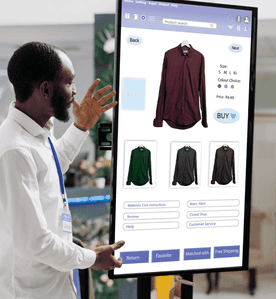5 Ways to Write Clear Problem Statement in UX Discovery
Sector: Digital Product, Technology, UI/UX
Author: Nisarg Mehta
Date Published: 07/29/2022

Contents
UX research begins with an entry point where a problem statement is required in order to collect data. The statement can be an improvement statement, a hypothesis, a business idea, or any entrepreneurial inspiration.
Creating a problem statement ensures that your team, including stakeholders and clients, is on the same page about who you are designing for, the problem you plan to solve, and the importance of doing so.
As a result, to work toward the same design goals as a whole team by expressing these things through a thoughtful, user-focused problem statement is what you want to achieve.
This article will take you through the anatomy of the problem statements in UX discovery.
You’ll get the answers to what problem statements are and how to write one for your use case.
So without further ado, let’s get started.
What are Problem Statements in UX Discovery?
A problem statement is the brief of a user pain point that needs to be solved with design.
In other words, a problem statement is an actionable summary of your user’s goals and the issues that must be addressed to satisfy them.
The problem statements have a clear direction for the user experience, although they don’t include any design details or user behavior. Instead, they inform you of your reasons for designing user experiences in the first place.
Using a problem statement, a team can focus on the issues they need to address and solve. It defines the boundaries of the investigation and outlines what must be accomplished. A well-crafted problem statement can be used to gain stakeholder support for investigating and resolving a challenge.
People often discuss UX Design challenges in terms of users’ pain or desires, but frankly, users aren’t even aware of what they have to solve or struggle with.
There is a famous quote by Henry Ford that perfectly supports this claim of ours.
“If I had asked people what they wanted, they would have said faster horses.”
It’s a wonderful example of how we should keep digging for answers and seek the cause of issues rather than accepting the answers users give us.
Examples of Problem Statements in UX Discovery
Enough for the theory, let’s read some of the best problem statements in UX discovery:
- Our EdTech app users often export the material from the app instead of sharing the content link through the app. It creates a problem for the information receiver because they won’t know the source and authenticity of the content; neither will our users increase. It’s an issue for app users as they have to take extra steps to share the content. This, overall, impacts their experience.
- Customer care reps spend a long time asking the customers about the service they’re using and the issues related to that. This drives a bad service experience for customers, resulting in high customer churn.
- Parents need an easily accessible platform to train their kids for internet scams. Currently, they have to browse through the internet to find authentic material.
- Working professionals need a platform to remind them to take short breaks during long working hours. Not taking frequent breaks is affecting their physical and mental health.
- Online buyers need an online platform that can get them access to authentic refurbished products. Currently, they’re using Best Buy and eBay to find refurbished products.
How to Write Problem Statement in UX Discovery
The research for the problem statement goes through several checkpoints. The UX researchers/designers need to go through the following in order to come up with problem statements that make sense:
1. Think of Your Customer
If you want to come up with a user-centric problem statement in UX discovery. It’s better if you start from the user’s perspective.
Following are different ways you can extract the problem statements from the users:
5 Ws Approach
You use the data you gathered during the empathize phase to answer the key queries: who, what, where, when, and why in the 5 Ws technique.
Whether you’re working with other members of the group or researching on your own, you’ll ask and answer questions beginning with the 5 Ws.
You’ll be able to describe who your users are, what they want, where they’ll use your product when the problem occurs, and why their problem is important by answering these questions.
- Who is affected by this problem? Specifically, who gets influenced by this problem? What are their demographics, personas, etc.?
- What is the problem? What obstacles are the users facing? How does this problem make their process less efficient?
- Where does the problem occur? Is there a special context where the problem arises?
- When does the problem occur? At what stage does the user face the problem?
- Why is the problem important? How will the users benefit by solving this problem?
Now, to construct a problem statement that is centered on the user, you must put into words the most critical observations that came out of your user research, which you then synthesize to arrive at a user-centric problem statement.
Asking 5 Whys
The 5 Whys method works much like the 5 Ws technique, except that each question is ‘why.’ This method helps you identify a dilemma’s fundamental cause by repeatedly questioning ‘why’ to your previous answer.
For instance, during user research, you discovered that buyer persona type A (let’s name it Roy) doesn’t have formals to wear at work. In this case, you can use the 5 Whys technique to get to the root of the problem:
- Why doesn’t Roy wear formals at work? – Because he doesn’t have formals to wear.
- Why doesn’t Roy have formals to wear? – Because he hasn’t shopped for formals in over a year.
- Why hasn’t Roy shopped for formals? – Because Roy hates to shop online.
- Why does Roy hate to shop online? – Because most of the time clothes don’t fit him as desired.
- Why do online-bought clothes not fit Roy? – Because brands have different sizes, and he has no idea which size will fit him.
The fifth Why indicates that the cause of Roy’s problem is that he doesn’t know which size would fit him, and that’s why he doesn’t buy formals online. As a result, the UX designers’ focus should be on easing out the sizing issue.
For this technique, 5 is just a rule of thumb. You can even ask more or fewer questions to get to the problem’s root.
Now when you’ve found the root of the problem. Now is the time to write the problem statement.
2. Use User Personas and Scenarios
In most cases, not all your users face the same problem. Hence, while writing problem statements, focus on the user personas that face the same problem.
Wonder what user personas are?
When you’re designing a product, your job as a UX designer is to build empathy for your target customers and determine exactly what they want. With user research, you begin by creating a user persona—a fictional representation of your ideal client.
And in this case, the user persona will be the fictional representation of the group of users facing the same problem.
The user personas can be defined with the following key information:
- Personal background
- Professional background
- User environment
- psychographics
- End goals
- Scenario, where the user interacts with our product
3. Use the Fill-in-the-Blank Technique to Write Problem Statement
According to Sarah Gibbons of Nielsen Norman Group, a problem statement can be structured in a simple manner using three elements – A user, A need, and A goal.
These three combined in a statement will form an accurate problem statement in the following manner – “[A user] needs [the need] to accomplish [the goal].”
Continuing the previous example, if the user is Roy, the problem statement will be – “Roy (the user) needs a better sizing system in the online app (the need) to buy frequently (the goal).”
4. Focus on One Problem at a Time
When you’re working on a discovery effort, you should keep your problem statement focused on just one problem.
Of course, a single issue may lead to other issues, and you can include those as well. However, if you’re handling too much, you’ll recognize it because you’ll have a lot of unrelated problems.
Also, when writing the problem statement, don’t focus on the solution; leave it for the later part.
At the end of your discovery, you will be in an ideal position to confidently put forward solutions that address the key problem and take into account what you have learned.
How to Use Problem Statements for UX Discovery
The problem statement can be used as the foundation for structuring UX discovery.
For example, if the issue was about improving the online-buying procedure, you would want to learn about ways to make the online buying process faster and simpler.
Once you have an investigation objective, it will be easier to pinpoint the unknowns that need research. For instance, in this example, you’d want to know the following:
- What process do online buyers find complex or challenging to go through?
- What does the end-to-end buying journey look like?
- What UX features can ease the process of selecting the right product?
When you begin to explore a problem, you might return to your problem statement and improve it—especially if you have discovered its underlying causes or the amount of money it can potentially cost your business.
For example, new areas of interest might be identified through explorative research, which may cause the discovery to shift direction.
Finally, after the discovery process, a problem statement can be used to describe the entire narrative, alongside your findings and recommendations.
Who the problem affects, how it affects them, and why it is important to solve it are all described in problem statements.
So what are you waiting for? Start writing the problem statement.
Latest Tech Insights!
Join our newsletter for the latest updates, tips, and trends.



